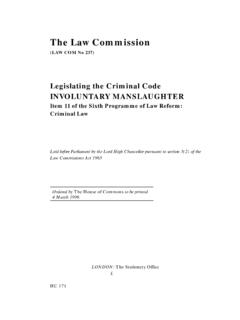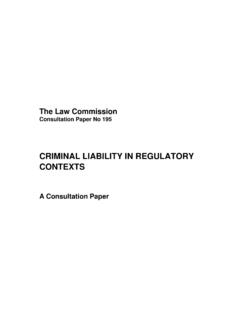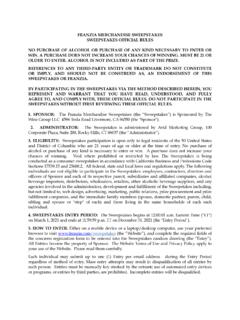Transcription of AGGRAVATED, EXEMPLARY AND RESTITUTIONARY …
1 1 THE LAW COMMISSION Item 2 of the Sixth Programme of Law Reform: Damages aggravated , EXEMPLARY ANDRESTITUTIONARY DAMAGES To the Right Honourable the Lord Irvine of Lairg, Lord High Chancellor of Great BritainPART IINTRODUCTION SCOPE OF THIS REPORT Damages are normally concerned to compensate the victim of a wrong. They aredesigned to make good, so far as possible, the pecuniary or non-pecuniary losssuffered by the victim by putting him or her into as good a position as if no wronghad occurred. In this paper we are, in contrast, primarily concerned withexemplary damages, which aim to punish the wrongdoer. We shall be confrontingsome major questions of policy for our civil law system. Should we continue torecognise punishment, as well as compensation, as a legitimate aim of awards forcivil wrongs?
2 If EXEMPLARY damages are to continue, in what circumstances shouldthey be available and how should they be assessed? We have had the opportunityto face these difficult issues of policy afresh, with the considerable benefit of theviews of consultees, and unconstrained, as the courts have been, by precedent. The modern boundaries of the remedy of EXEMPLARY damages were fashioned bythe courts on the assumption that they are an anomalous civil remedy, and mustbe limited as far as precedents Few, whether opposing or in favour ofexemplary damages, would argue that the boundaries so set are consistent witheither sound principle or sound policy. Later in this Introduction2 we give someexamples of cases in which, we, in agreement with many consultees, consider thatthere is a practical need for EXEMPLARY damages to be available, but for which theyare, at present, denied.
3 These include, in particular, cases in which a victim sclaim will fail, however outrageous the defendant s wrongdoing, and howeverinadequate the available alternative sanctions, simply because: (1) it does not fall within one or other of two limited categories of case (abuseof power by public servants and wrongdoing which is calculatedly profit-seeking);3 (2) it is for a wrong, such as unlawful sex discrimination, for which no pre-1964 authorities can be discovered in which EXEMPLARY damages wereawarded for the wrong in question;4 or1 See, in particular, the discussion of Rookes v Barnard [1964] AC 1129 and AB v South WestWater Services Ltd [1993] QB 507 at paras See para below, examples (5)-(10).3 See para below, examples (5), (6) and (9).2 (3) the wrongdoer s conduct has affected a large number of people, and socaused a large number of claims to be made in respect of Even if the law were not open to objection on the above ground, reform would stillbe required, we suggest, due to the unsatisfactory manner in which exemplarydamages are Although reasoned, consistent and proportionate awardsare vital, there are few clear principles to guide courts towards this result.
4 And,indeed, such awards are almost impossible to achieve if, as at present, juries mayhave the task of deciding the quantum of EXEMPLARY damages. We shall also be considering the two other major types of exceptional damagesrecognised in English law: aggravated damages, which have often been confusedwith EXEMPLARY damages; and RESTITUTIONARY damages, which are damages whichaim to strip away some or all of the gains made by a defendant from a civil wrong. Although we call these three types of damages ( EXEMPLARY , aggravated andrestitutionary) exceptional , we do not thereby seek to minimise the importance ofthis topic. Very few would seek to defend the present law. Reform, especially ofthe law on EXEMPLARY damages, is widely agreed to be As Lord JusticeStephenson stated in Riches v News Group Newspapers,8 the present state of the law.
5 Cries aloud for Parliamentary intervention .9 Publication of this reportprovides a unique opportunity to rationalise and clarify the aims and purposes ofthe English law of damages. CONSULTATION PROCESS Our consultation paper on these damages, aggravated , EXEMPLARY and RestitutionaryDamages,10 was published in Autumn 1993. The topic of EXEMPLARY damages, inparticular, provoked a wide range of strongly-held views from it appeared that a clear majority favoured the retention of exemplarydamages, the diversity of views left us in some doubt as to where the consensus ofopinion lay as regards the future of EXEMPLARY damages. We therefore took theunusual step of issuing a supplementary consultation paper in August 1995. Thatpaper outlined three models for reform and asked consultees to express theirpreference.
6 The process confirmed that a considerable majority of consulteesfavoured the retention of EXEMPLARY damages. We describe the three models andthe results of the process in more detail in Part A list of those who respondedto the two papers appears in Appendices B and C. Although the decision to havetwo consultation exercises led to a long delay in formulating our final proposals, we4 See para below, examples (5), (7), (8), (9) and (10).5 See para below, example (9). See also the discussion of multiple plaintiff claims andAB v South West Water Services Ltd [1993] QB 507 at para See, in particular, the discussion at paras , and See para [1986] QB [1986] QB 256, (1993) Consultation Paper No See paras emphasise at the outset that we have derived enormous assistance from theresponses of the consultees to the two consultation papers. OF OUR RECOMMENDATIONS AND REASONING (1) aggravated damages In Part II of this Report we review the present law on aggravated damages, and inparticular, the confusion that has surrounded their aims.
7 Are they a punitivemeasure of damages, like EXEMPLARY damages, or are they compensatory? Our conclusion is that aggravated damages compensate the victim of a wrong formental distress (or injury to feelings ) in circumstances in which that injury hasbeen caused or increased by the manner in which the defendant committed thewrong, or by the defendant s conduct subsequent to the There is nojustification for the law recognising a punitive civil remedy that is both additionalto EXEMPLARY damages, and unconstrained by the severe constraints which the lawimposes on the availability of the The difficulties which uncertainty in thisarea has caused in practice were recently highlighted in the Court of Appeal sdecision in Thompson v We discuss that decision in detail in Part II. We think it vital to dispel such confusion once and for all.
8 Our recommendationsaim to do so. We recommend that statute should clarify that aggravated damagesare concerned to compensate and not to punish the wrongdoer,15 and further that,wherever possible, the label damages for mental distress should be used instead ofthe misleading phrase aggravated damages .16 Once it is appreciated thataggravated damages are concerned with circumstances in which the victim of acivil wrong may obtain compensation for mental distress which he or she hassuffered, a more coherent perception, and so development of, the law on damagesfor mental distress should be (2) RESTITUTIONARY damages In Part III of this Report we review the present law relating to the availability ofrestitution for a wrong. We shall see that restitution is well-recognised for sometypes of wrong,18 but that its availability is disputed in relation to several shall also see that, where recognised, restitution will currently be effected by12 See paras and See para [1997] 3 WLR See paras , recommendation (1), and draft Bill, clause 13, See paras , recommendation (2), and draft Bill, clause 13, below17 See, in particular, para See Part III: section 2(1)(a) (proprietary torts, excluding intellectual property torts), atparas below; section 2(1)(b) (intellectual property torts), at paras ; and section 2(2) (equitable wrongs), at paras See Part III: section 2(1)(c) (non-proprietary torts), at paras below; and section2(3) (breach of contract), at paras of one or more of several different remedies: an action for money had andreceived.
9 An account of profits ; and ( RESTITUTIONARY ) damages . Our conclusion is that development of the law on restitution for wrongs is, ingeneral, most appropriately left to the No attempt should be made tostate comprehensively in legislation which civil wrongs can trigger restitution, orwhen they should do This position had the support of a large majority ofconsultees. Nevertheless, it would be desirable if the law were to develop towards having asingle, RESTITUTIONARY remedy for wrongs, rather than the range of remedies whichcurrently fulfil that More importantly, we recommend that a limitedmeasure of legislative reform is required as a result of our recommendationsrelating to EXEMPLARY damages. RESTITUTIONARY damages are a less extreme remedythan EXEMPLARY damages.
10 We recommend that they should be available (at least)where EXEMPLARY damages could be (3) EXEMPLARY damages It is in relation to the remedy of EXEMPLARY damages that reform of the law is mostneeded. It is also in relation to this remedy that we make our most far-reachingrecommendations. We shall see in Part IV that the availability of exemplarydamages under English law is, at present, artificially In broad terms,an award can only be made for a limited set of civil wrongs ( the cause of actiontest )25 and in only a limited set of circumstances in which those wrongs arecommitted ( the categories test ).26 (a)What direction should reform of EXEMPLARY damages take? Almost without exception, consultees considered that the current legal positioncould not be justified; the status quo should not be maintained.











